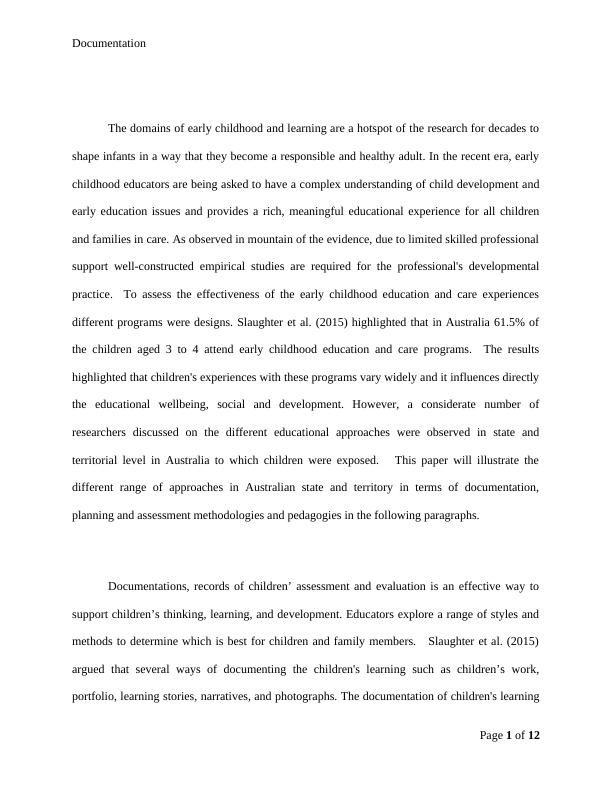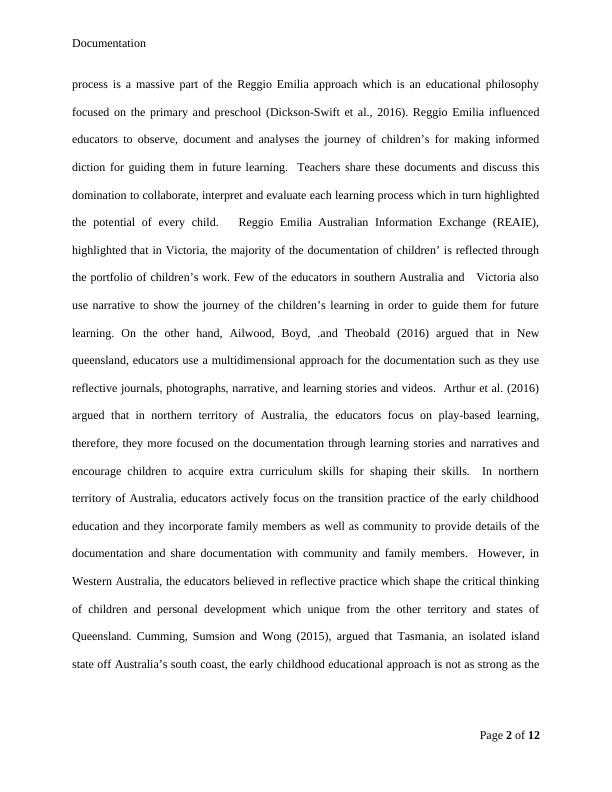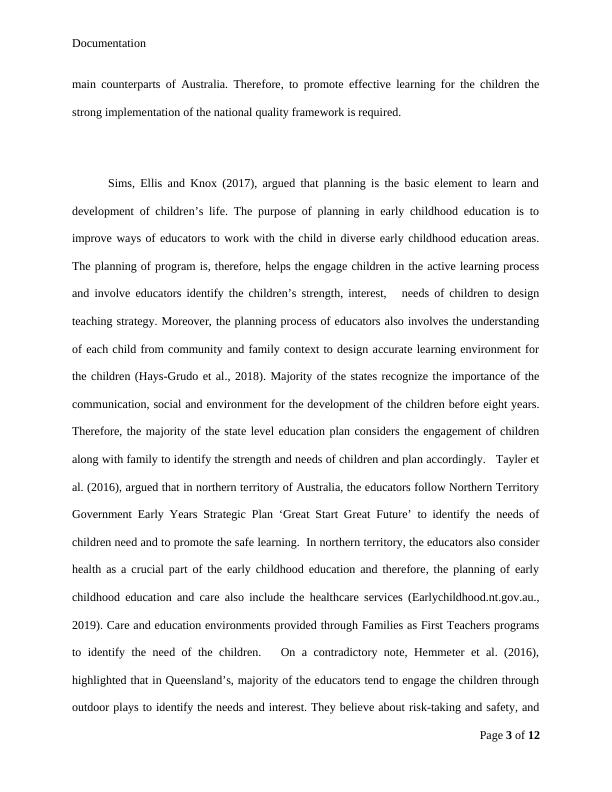Documentation: Educational Approaches in Australian State and Territory
Added on 2023-04-25
12 Pages3311 Words132 Views
documentation
Heena Verma
Heena Verma

Documentation
The domains of early childhood and learning are a hotspot of the research for decades to
shape infants in a way that they become a responsible and healthy adult. In the recent era, early
childhood educators are being asked to have a complex understanding of child development and
early education issues and provides a rich, meaningful educational experience for all children
and families in care. As observed in mountain of the evidence, due to limited skilled professional
support well-constructed empirical studies are required for the professional's developmental
practice. To assess the effectiveness of the early childhood education and care experiences
different programs were designs. Slaughter et al. (2015) highlighted that in Australia 61.5% of
the children aged 3 to 4 attend early childhood education and care programs. The results
highlighted that children's experiences with these programs vary widely and it influences directly
the educational wellbeing, social and development. However, a considerate number of
researchers discussed on the different educational approaches were observed in state and
territorial level in Australia to which children were exposed. This paper will illustrate the
different range of approaches in Australian state and territory in terms of documentation,
planning and assessment methodologies and pedagogies in the following paragraphs.
Documentations, records of children’ assessment and evaluation is an effective way to
support children’s thinking, learning, and development. Educators explore a range of styles and
methods to determine which is best for children and family members. Slaughter et al. (2015)
argued that several ways of documenting the children's learning such as children’s work,
portfolio, learning stories, narratives, and photographs. The documentation of children's learning
Page 1 of 12
The domains of early childhood and learning are a hotspot of the research for decades to
shape infants in a way that they become a responsible and healthy adult. In the recent era, early
childhood educators are being asked to have a complex understanding of child development and
early education issues and provides a rich, meaningful educational experience for all children
and families in care. As observed in mountain of the evidence, due to limited skilled professional
support well-constructed empirical studies are required for the professional's developmental
practice. To assess the effectiveness of the early childhood education and care experiences
different programs were designs. Slaughter et al. (2015) highlighted that in Australia 61.5% of
the children aged 3 to 4 attend early childhood education and care programs. The results
highlighted that children's experiences with these programs vary widely and it influences directly
the educational wellbeing, social and development. However, a considerate number of
researchers discussed on the different educational approaches were observed in state and
territorial level in Australia to which children were exposed. This paper will illustrate the
different range of approaches in Australian state and territory in terms of documentation,
planning and assessment methodologies and pedagogies in the following paragraphs.
Documentations, records of children’ assessment and evaluation is an effective way to
support children’s thinking, learning, and development. Educators explore a range of styles and
methods to determine which is best for children and family members. Slaughter et al. (2015)
argued that several ways of documenting the children's learning such as children’s work,
portfolio, learning stories, narratives, and photographs. The documentation of children's learning
Page 1 of 12

Documentation
process is a massive part of the Reggio Emilia approach which is an educational philosophy
focused on the primary and preschool (Dickson-Swift et al., 2016). Reggio Emilia influenced
educators to observe, document and analyses the journey of children’s for making informed
diction for guiding them in future learning. Teachers share these documents and discuss this
domination to collaborate, interpret and evaluate each learning process which in turn highlighted
the potential of every child. Reggio Emilia Australian Information Exchange (REAIE),
highlighted that in Victoria, the majority of the documentation of children’ is reflected through
the portfolio of children’s work. Few of the educators in southern Australia and Victoria also
use narrative to show the journey of the children’s learning in order to guide them for future
learning. On the other hand, Ailwood, Boyd, .and Theobald (2016) argued that in New
queensland, educators use a multidimensional approach for the documentation such as they use
reflective journals, photographs, narrative, and learning stories and videos. Arthur et al. (2016)
argued that in northern territory of Australia, the educators focus on play-based learning,
therefore, they more focused on the documentation through learning stories and narratives and
encourage children to acquire extra curriculum skills for shaping their skills. In northern
territory of Australia, educators actively focus on the transition practice of the early childhood
education and they incorporate family members as well as community to provide details of the
documentation and share documentation with community and family members. However, in
Western Australia, the educators believed in reflective practice which shape the critical thinking
of children and personal development which unique from the other territory and states of
Queensland. Cumming, Sumsion and Wong (2015), argued that Tasmania, an isolated island
state off Australia’s south coast, the early childhood educational approach is not as strong as the
Page 2 of 12
process is a massive part of the Reggio Emilia approach which is an educational philosophy
focused on the primary and preschool (Dickson-Swift et al., 2016). Reggio Emilia influenced
educators to observe, document and analyses the journey of children’s for making informed
diction for guiding them in future learning. Teachers share these documents and discuss this
domination to collaborate, interpret and evaluate each learning process which in turn highlighted
the potential of every child. Reggio Emilia Australian Information Exchange (REAIE),
highlighted that in Victoria, the majority of the documentation of children’ is reflected through
the portfolio of children’s work. Few of the educators in southern Australia and Victoria also
use narrative to show the journey of the children’s learning in order to guide them for future
learning. On the other hand, Ailwood, Boyd, .and Theobald (2016) argued that in New
queensland, educators use a multidimensional approach for the documentation such as they use
reflective journals, photographs, narrative, and learning stories and videos. Arthur et al. (2016)
argued that in northern territory of Australia, the educators focus on play-based learning,
therefore, they more focused on the documentation through learning stories and narratives and
encourage children to acquire extra curriculum skills for shaping their skills. In northern
territory of Australia, educators actively focus on the transition practice of the early childhood
education and they incorporate family members as well as community to provide details of the
documentation and share documentation with community and family members. However, in
Western Australia, the educators believed in reflective practice which shape the critical thinking
of children and personal development which unique from the other territory and states of
Queensland. Cumming, Sumsion and Wong (2015), argued that Tasmania, an isolated island
state off Australia’s south coast, the early childhood educational approach is not as strong as the
Page 2 of 12

Documentation
main counterparts of Australia. Therefore, to promote effective learning for the children the
strong implementation of the national quality framework is required.
Sims, Ellis and Knox (2017), argued that planning is the basic element to learn and
development of children’s life. The purpose of planning in early childhood education is to
improve ways of educators to work with the child in diverse early childhood education areas.
The planning of program is, therefore, helps the engage children in the active learning process
and involve educators identify the children’s strength, interest, needs of children to design
teaching strategy. Moreover, the planning process of educators also involves the understanding
of each child from community and family context to design accurate learning environment for
the children (Hays-Grudo et al., 2018). Majority of the states recognize the importance of the
communication, social and environment for the development of the children before eight years.
Therefore, the majority of the state level education plan considers the engagement of children
along with family to identify the strength and needs of children and plan accordingly. Tayler et
al. (2016), argued that in northern territory of Australia, the educators follow Northern Territory
Government Early Years Strategic Plan ‘Great Start Great Future’ to identify the needs of
children need and to promote the safe learning. In northern territory, the educators also consider
health as a crucial part of the early childhood education and therefore, the planning of early
childhood education and care also include the healthcare services (Earlychildhood.nt.gov.au.,
2019). Care and education environments provided through Families as First Teachers programs
to identify the need of the children. On a contradictory note, Hemmeter et al. (2016),
highlighted that in Queensland’s, majority of the educators tend to engage the children through
outdoor plays to identify the needs and interest. They believe about risk-taking and safety, and
Page 3 of 12
main counterparts of Australia. Therefore, to promote effective learning for the children the
strong implementation of the national quality framework is required.
Sims, Ellis and Knox (2017), argued that planning is the basic element to learn and
development of children’s life. The purpose of planning in early childhood education is to
improve ways of educators to work with the child in diverse early childhood education areas.
The planning of program is, therefore, helps the engage children in the active learning process
and involve educators identify the children’s strength, interest, needs of children to design
teaching strategy. Moreover, the planning process of educators also involves the understanding
of each child from community and family context to design accurate learning environment for
the children (Hays-Grudo et al., 2018). Majority of the states recognize the importance of the
communication, social and environment for the development of the children before eight years.
Therefore, the majority of the state level education plan considers the engagement of children
along with family to identify the strength and needs of children and plan accordingly. Tayler et
al. (2016), argued that in northern territory of Australia, the educators follow Northern Territory
Government Early Years Strategic Plan ‘Great Start Great Future’ to identify the needs of
children need and to promote the safe learning. In northern territory, the educators also consider
health as a crucial part of the early childhood education and therefore, the planning of early
childhood education and care also include the healthcare services (Earlychildhood.nt.gov.au.,
2019). Care and education environments provided through Families as First Teachers programs
to identify the need of the children. On a contradictory note, Hemmeter et al. (2016),
highlighted that in Queensland’s, majority of the educators tend to engage the children through
outdoor plays to identify the needs and interest. They believe about risk-taking and safety, and
Page 3 of 12

End of preview
Want to access all the pages? Upload your documents or become a member.
Related Documents
Exploring Early Childhood Education Approaches: Documentation, Planning, and Assessment in Australian Contextlg...
|12
|3338
|155
Assignment on Early Childhood Curriculum Developmentlg...
|7
|1300
|388
Assignment on Sociology - The Reggio Emilialg...
|6
|1524
|14
Critiquing Documentation And Curriculumlg...
|13
|3585
|34
Approaches of Documentation, Planning, Assessment Methodologies and Pedagogy in Child Carelg...
|13
|3562
|93
EARLY CHILDHOOD EDUCATION AND CARE Early childhood education andlg...
|3
|352
|147
